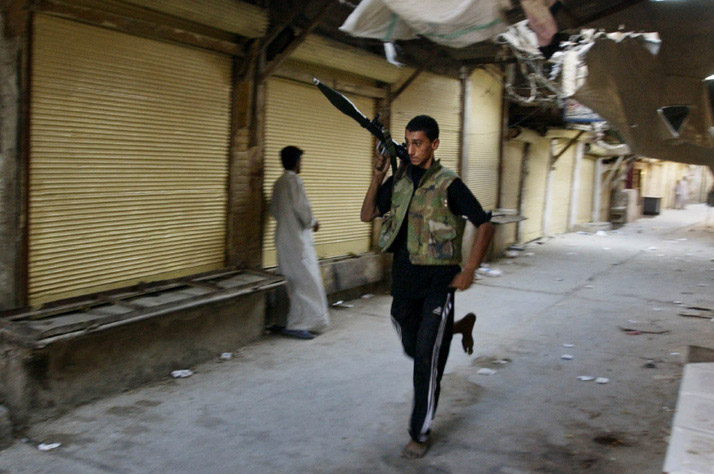
Najaf, Iraq, 26 August 2004. A fighter running with rocket propelled grenade launcher prepares to defend the collapsing perimeter of the Mahdi forces.
Photo: Thorne Anderson, Corbis.
Dead fighters were carried in a slow circuit around the tomb by their comrades. Wrapped in white martyr bags, the young men carried their friends and chanted, "There is no god, but God." Because the cemetery was a battleground, the bodies were taken to the Islamic court where they rotted in the basement. These processions happened every few minutes. The cycle was simple: fighters ran down Rasul Street, fought the Americans, were wounded or killed, then were hauled back to the shrine in the blood-stained wooden cart. The same scene repeated over and over again.
We spoke to another cleric, Sayeed Hosam al Husseini, and finally made contact with Sheikh Ahmed Sheibani when he returned from the main conference room. Men were now pouring through the gates of the mosque. As night came on with no pause in the bombing, there were close to two thousand people taking shelter inside the massive walls. Men ate on mats in small clusters according to which group they fought with, while the clerics sat with the commanders of the cells and planned the offensive. After evening prayers when the stars came out, they stretched out to sleep. Thorne slept in the Sheikh's office, while I found a place on a mat next to a group of fighters. All through the night, rounds passed over the walls making weird zinging sounds.
As the Mahdi forces fell back toward the shrine walls, some of the men taking shelter in the mosque started to crack. There was nowhere to go. Marine snipers picked off men dashing across the street to the gates for shelter. Shards of metal slammed into the minarets while the shockwaves sent a rain of stunned birds down from the eaves. The courtyard of the mosque had become a hurricane's eye of machines and flying lead.
The fighting slowed down when the militiamen came in for evening prayers. As night fell, the clerics would illuminate the gold dome turning it into a beacon above the dark city. The lights would stay on until the generator ran out of fuel. During one of these blackouts, on August 18, a thin young man began screaming, making a sound halfway between ecstasy and terror. The lights had just gone out and the young man pointed to one of the archways in the second storey of the western wall. At first we thought that Moqtada was going to address the thousands of men in the shrine from a balcony. Yassir translated for the young man, who told us, "I just saw a vision of the Mahdi. He appeared there!"
"No, it was Imam Ali." Another said.
The crowd came and collected around the visionary. Dozens of other Mahdi Army fighters claimed to have seen the same image, a flickering saint in an alcove.
"What does it mean when the Mahdi returns?" I asked the fighter.
"It means he will come to deliver us from injustice and destroy our enemies with incredible weapons. America will be finished."
After some time, the crowd quieted down, but long after that I saw them looking at the
balcony for another sign, anything that would have saved them.![]()
© Phillip Robertson, 2009-2020.
